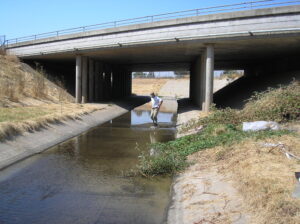Method for screening pesticides in water bodies validated for statewide accreditation

SCCWRP and its partners have successfully validated a new statewide method for detecting and measuring up to 140 pesticides simultaneously using an integrated set of processing and analysis steps – an effort that paves the way for statewide accreditation of the method.
The method validation work, completed last spring, will serve as the scientific foundation for California’s Environmental Laboratory Accreditation Program (ELAP) to consider accrediting laboratories to use the method to generate State environmental data.
The method is designed for use with both grab water samples and passive sampling devices that sorb contaminants in water bodies. It eliminates the need for managers to turn to a diverse range of siloed processing and analysis methods to measure a broad array of current-use pesticides. These labor-intensive legacy methods have limited the number of individual pesticides that are practical to screen on a routine basis.
SCCWRP’s role was to develop standard operating procedures (SOPs) and coordinate a multi-laboratory study (San José-Santa Clara Regional Wastewater Facility, Physis Environmental Laboratories, and Weck Laboratories) to validate the effectiveness of the method; both are necessary precursors for ELAP to consider statewide accreditation of the method.
California has historically lacked a single, streamlined method for screening water bodies for a broad suite of current-use pesticides. Although the U.S. Environmental Protection Agency (USEPA) has developed guidance for using passive samplers to measure legacy pesticides like DDT – as well as other types of contaminants like polycyclic aromatic hydrocarbons (PAHs) and polychlorinated biphenyls (PCBs) – there is little guidance on how to monitor current-use pesticides using passive samplers, whether in a consolidated or one-off fashion.
The method that SCCWRP and its partners validated was originally developed a decade ago by the Central Valley Regional Water Quality Control Board and the U.S. Geological Survey; the goal was to take advantage of passive sampling technology to screen water bodies for pesticides commonly used in agriculture and cannabis cultivation.
Passive samplers use simple polymer films that gradually sorb chemical contaminants in the water column; they can detect low contaminant levels that traditional sampling techniques may miss.
While many California monitoring programs still use traditional sampling methods for measuring pesticides, there is interest in using passive sampling methods for screening pesticides in agricultural and urban runoff.
California’s Environmental Laboratory Accreditation Program (ELAP) announced in June its decision to develop capacity to accredit environmental laboratories to use the method. The accrediting body, which is responsible for assessing the competency of public and private laboratories across California, plays a key role in protecting the integrity of environmental data used in management decision-making.
Already, researchers have piloted the method to screen for pesticides in multiple Southern California water bodies.
SCCWRP also is planning to host a training workshop for assessors who review environmental laboratories in California as the final step prior to ELAP considering method adoption.
For more information, contact Dr. Danhui Xin or Dr. Charles Wong.
More news related to: Emerging Contaminants, Top News